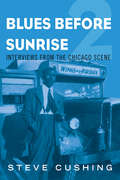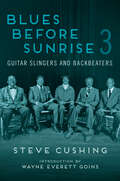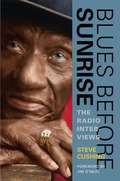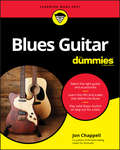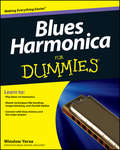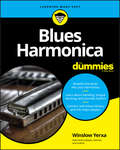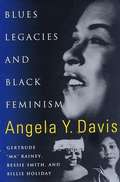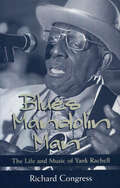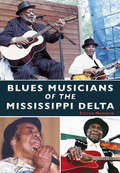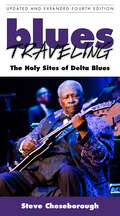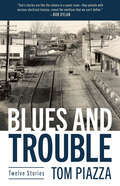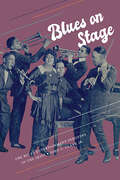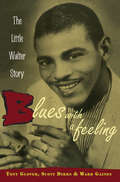- Table View
- List View
Blues Before Sunrise 2: Interviews from the Chicago Scene (Music in American Life)
by Steve CushingIn this new collection of interviews, Steve Cushing once again invites readers into the vaults of Blues Before Sunrise, his acclaimed nationally syndicated public radio show. Icons from Memphis Minnie to the Gay Sisters stand alongside figures like schoolteacher Flossie Franklin, who helped Leroy Carr pen some of his most famous tunes; saxman Abb Locke and his buddy Two-Gun Pete, a Chicago cop notorious for killing people in the line of duty; and Scotty "The Dancing Tailor" Piper, a font of knowledge on the black entertainment scene of his day. Cushing also devotes a section to religious artists, including the world-famous choir Wings Over Jordan and their travails touring and performing in the era of segregation. Another section focuses on the jazz-influenced Bronzeville scene that gave rise to Marl Young, Andrew Tibbs, and many others while a handful of Cushing's early brushes with the likes of Little Brother Montgomery, Sippi Wallace, and Blind John Davis round out the volume.Diverse and entertaining, Blues Before Sunrise 2 adds a chorus of new voices to the fascinating history of Chicago blues.
Blues Before Sunrise 3: Guitar Slingers and Backbeaters (Music in American Life)
by Steve CushingSteve Cushing’s third volume of interviews from Blues Before Sunrise puts fans face-to-face with music legends and industry figures. The volume kicks off with a roundtable featuring drumming all-stars Earl Phillips, S.P. Leary, Odie Payne, Clifton James, and Fred Below discussing their lives and craft. Cushing segues to one-on-one interviews with Howlin’ Wolf sideman Phillips; Leary, a fellow Wolf alum and player with Sonny Boy Williamson II; Payne, known for his kick drum technique; longtime Muddy Waters drummer Willie “Big Eyes” Smith; next-generation standard bearer and session mainstay Casey Jones; and King Records house drummer Phillip Paul. Interviews with guitarists include talks with Honeyboy Edwards, whose friendships with innumerable Chicago blues legends (and Robert Johnson) predated the Great Migration; jazz player turned bluesman Guitar Shorty; and figures like Texas native Roy Gaines, Johnny Heartsman of Oakland, and Memphis-born Floyd Murphy. A final section offers interviews with vocalists, record label founders, and other figures. Music scholar Wayne Everett Goins provides an introduction on blues history, blues style, and the careers of the featured artists. Interviews: Joel Dorn, Honeyboy Edwards, Slim Gaillard, Roy Gaines, Johnny Heartsman, Franz Jackson, Casey Jones, S.P. Leary, Floyd Murphy, Jimmy “T-99” Nelson, Johnny Parth, Phillip Paul, Odie Payne, Earl Phillips, Art Sheridan, Guitar Shorty, Willie “Big Eyes” Smith, and Norvel Taborn
Blues Before Sunrise: The Radio Interviews
by Steve Cushing Jim O'NealThis collection assembles the best interviews from Steve Cushing's long-running radio program Blues Before Sunrise, the nationally syndicated, award-winning program focusing on vintage blues and R&B. As both an observer and performer, Cushing has been involved with the blues scene in Chicago for decades. His candid, colorful interviews with prominent blues players, producers, and deejays reveal the behind-the-scenes world of the formative years of recorded blues. Many of these oral histories detail the careers of lesser-known but greatly influential blues performers and promoters. The book focuses in particular on pre-World War II blues singers, performers active in 1950s Chicago, and nonperformers who contributed to the early blues world. Interviewees include Alberta Hunter, one of the earliest African American singers to transition from Chicago's Bronzeville nightlife to the international spotlight, and Ralph Bass, one of the greatest R&B producers of his era. Blues expert, writer, record producer, and cofounder of Living Blues Magazine Jim O'Neal provides the book's foreword.
Blues Empress in Black Chattanooga: Bessie Smith and the Emerging Urban South
by Michelle R. ScottAs one of the first African American vocalists to be recorded, Bessie Smith is a prominent figure in American popular culture and African American history. Michelle R. Scott uses Smith's life as a lens to investigate broad issues in history, including industrialization, Southern rural to urban migration, black community development in the post-emancipation era, and black working-class gender conventions. Arguing that the rise of blues culture and the success of female blues artists like Bessie Smith are connected to the rapid migration and industrialization in the late nineteenth and early twentieth centuries, Scott focuses her analysis on Chattanooga, Tennessee, the large industrial and transportation center where Smith was born. This study explores how the expansion of the Southern railroads and the development of iron foundries, steel mills, and sawmills created vast employment opportunities in the postbellum era. Chronicling the growth and development of the African American Chattanooga community, Scott examines the Smith family's migration to Chattanooga and the popular music of black Chattanooga during the first decade of the twentieth century, and culminates by delving into Smith's early years on the vaudeville circuit.
Blues Guitar For Dummies
by Jon ChappellSelect the right guitar and accessories Learn the riffs and scales that define the blues Play solid blues rhythm or step out for a solo Recreate the sounds of the blues masters Want to play the blues? Can't read music? No problem! This fun, accessible guide shows you how to play blues scales, chords, progressions, riffs, and solos. Learn about the structure of a blues song, including intros, turnarounds, and endings. Master the art of articulation, dynamics, and phrasing. From Delta blues and modern blues to blues rock, you'll see how to use today's guitars, amplifiers, and effects to play a wide variety of styles, with hands-on guidance on changing strings for when you really boogie down. Inside Explore acoustic and electric styles Perform common blues scales Learn song structures and improvise leads Follow the history of the blues Choose the best equipment to accentuate your sound Get to know legendary blues artists and albums
Blues Guitar For Dummies
by Jon ChappellDo you wish you could play your favorite blues music on guitar? Even if you don’t read music, it’s not difficult with Blues Guitar for Dummies. With this hands-on guide, you’ll pick up the fundamentals instantly and start jamming like your favorite blues artists! Blues Guitar for Dummies covers all aspects of blues guitar, showing you how to play scales, chords, progressions, riffs, solos, and more! It’s packed with musical examples, chords charts, and photos that let you explore the genre and play the songs of the great blues musicians. This accessible guide will give you the skills you need to: Choose the right guitar, equipment, and strings Hold, tune, and get situated with your guitar Play barre chords and strum to the rhythm Recognize the structure of a blues song Tackle musical riffs Master melodies and solos Make your guitar sing, cry, and wail Jam to any type of blues In addition to this must-have book, a bonus CD is included so that you can listen to famous songs, practice your riffs and chords, and develop your style as a blues musician. It also features a quick guide to musical notation and suggestions on albums, artists, and guitars for further enjoyment. With Blues Guitar for Dummies, you can re-create the masterpieces of the blues legend without the expensive lessons!
Blues Guitar For Dummies
by Jon ChappellSelect the right guitar and accessories Learn the riffs and scales that define the blues Play solid blues rhythm or step out for a solo Recreate the sounds of the blues masters Want to play the blues? Can't read music? No problem! This fun, accessible guide shows you how to play blues scales, chords, progressions, riffs, and solos. Learn about the structure of a blues song, including intros, turnarounds, and endings. Master the art of articulation, dynamics, and phrasing. From Delta blues and modern blues to blues rock, you'll see how to use today's guitars, amplifiers, and effects to play a wide variety of styles, with hands-on guidance on changing strings for when you really boogie down. Inside Explore acoustic and electric styles Perform common blues scales Learn song structures and improvise leads Follow the history of the blues Choose the best equipment to accentuate your sound Get to know legendary blues artists and albums
Blues Harmonica For Dummies
by Winslow YerxaThe fun and easy way to play blues on the harmonica Blues harmonica is the most popular and influential style of harmonica playing, and it forms the basis for playing harmonica in other styles such as rock and country. Blues Harmonica for Dummies gives you a wealth of content devoted to the blues approach--specific techniques and applications, including bending and making your notes sound richer and fuller with tongue-blocked enhancements; use of amplification to develop a blues sound; blues licks and riffs; constructing a blues harmonica solo; accompanying singers; historical development of blues styles; and important blues players and recordings. The accompanying audio CD features all the musical examples from the book, plus play-along exercises and songs that let you hear the sound you're striving for. In-depth coverage of major blues harmonica techniques Blues song forms, improvisation, and accompanying singers Information on blues history and personalities If you're intrigued by the idea of understanding and mastering the compelling (yet mysterious) art of playing blues on the harmonica, Blues Harmonica For Dummies has you covered. CD-ROM/DVD and other supplementary materials are not included as part of the e-book file, but are available for download after purchase
Blues Harmonica For Dummies
by Winslow YerxaBlues Harmonica For Dummies (9781119694519) was previously published as Blues Harmonica For Dummies (9781118252697). While this version features a new Dummies cover and design, the content is the same as the prior release and should not be considered a new or updated product.
Blues Harmonica For Dummies
by Winslow YerxaBreathe the blues into your harmonica Learn about bending, tongue blocking, and chordal rhythm Connect with blues history and the major players The fun and easy way to play blues harmonica Blues Harmonica For Dummies gives you a wealth of guidance on playing harmonica in the style of the blues masters. Learn how to go from playing easy chords to strong single notes — and then to 12-bar blues. Develop your personal style and put together a repertoire of tunes to play for an audience. Explore specific techniques and applications, including bending and making your notes sound richer and fuller; using amplification; developing blues licks and riffs; performing a blues harmonica solo like a pro; and much more. Inside... A review of the blues as a musical style What it takes to get started A blues guide to music symbols Ways to shape, color, and punctuate your blues sound How to amplify your playing Important blues players and recordings
Blues Legacies and Black Feminism: Gertrude "Ma" Rainey, Bessie Smith, and Billie Holiday
by Angela Y. DavisThe author of "Women, Race and Class" suggests that "Ma" Rainey, Bessie Smith, and Billie Holiday represent a black working-class, feminist ideology and historical consciousness. Davis' illuminating analysis of the songs performed by these artists provides readers with a compelling and transformative understanding of their musical and social contributions and of their relation to both the African-American community and American culture.
Blues Legacies and Black Feminism: Gertrude Ma Rainey, Bessie Smith, and Billie Holiday
by Angela Y. DavisFrom one of this country's most important intellectuals comes a brilliant analysis of the blues tradition that examines the careers of three crucial black women blues singers through a feminist lens. Angela Davis provides the historical, social, and political contexts with which to reinterpret the performances and lyrics of Gertrude "Ma" Rainey, Bessie Smith, and Billie Holiday as powerful articulations of an alternative consciousness profoundly at odds with mainstream American culture. The works of Rainey, Smith, and Holiday have been largely misunderstood by critics. Overlooked, Davis shows, has been the way their candor and bravado laid the groundwork for an aesthetic that allowed for the celebration of social, moral, and sexual values outside the constraints imposed by middle-class respectability. Through meticulous transcriptions of all the extant lyrics of Rainey and Smith--published here in their entirety for the first time--Davis demonstrates how the roots of the blues extend beyond a musical tradition to serve as a conciousness-raising vehicle for American social memory. A stunning, indispensable contribution to American history, as boldly insightful as the women Davis praises, Blues Legacies and Black Feminism is a triumph.
Blues Legacy: Tradition and Innovation in Chicago (Music in American Life #489)
by David WhiteisChicago blues musicians parlayed a genius for innovation and emotional honesty into a music revered around the world. As the blues evolves, it continues to provide a soundtrack to, and a dynamic commentary on, the African American experience: the legacy of slavery; historic promises and betrayals; opportunity and disenfranchisement; the ongoing struggle for freedom. Through it all, the blues remains steeped in survivorship and triumph, a music that dares to stare down life in all its injustice and iniquity and still laugh--and dance--in its face. David Whiteis delves into how the current and upcoming Chicago blues generations carry on this legacy. Drawing on in-person interviews, Whiteis places the artists within the ongoing social and cultural reality their work reflects and helps create. Beginning with James Cotton, Eddie Shaw, and other bequeathers, he moves through an all-star council of elders like Otis Rush and Buddy Guy and on to inheritors and today's heirs apparent like Ronnie Baker Brooks, Shemekia Copeland, and Nellie "Tiger" Travis. Insightful and wide-ranging, Blues Legacy reveals a constantly adapting art form that, whatever the challenges, maintains its links to a rich musical past.
Blues Mandolin Man: The Life and Music of Yank Rachell
by Richard CongressYank Rachell and his mandolin playing style moved every musician lucky enough to hear him perform in the early sixties. When he died in April 1997, he left behind a stack of unanswered requests to tour Europe and to play blues festivals in the United States. In Blues Mandolin Man: The Life and Music of Yank Rachell, Richard Congress delivers the first biography of a family man whose playing inspired and energized the likes of David Honeyboy Edwards, Sleepy John Estes, and Henry Townsend. No other biography discusses the mandolin's influence and role in the blues. Guitar great Ry Cooder said, "Yank's style fascinated me because it had a lot of power and it's very raw-and what a great thing to do, just attack this little instrument like that." Charlie Musselwhite, the noted harp player, worked with Rachell and club hopped in Chicago with the elder bluesman. "He just had a great spirit about him," Musselwhite said of Rachell's playing and singing, "really just shouting it out. If the world was made up of people like Yank Rachell it would be a wonderful place to live." Blues Mandolin Man chronicles the life, times, and music of a man who was born into a family of sharecroppers in 1910 in rural western Tennessee. An active musician for 75 years, Rachell mastered several musical instruments and first recorded for Victor in Memphis in 1929. Through the blues, Rachell's world expanded to include Chicago, New York, recording studios and, after the sixties, radio, TV, and national and European tours. Yank's recollections reveal new information about personalities and events that will delight blues history buffs. Rich appendixes detail Yank's mandolin and guitar style and his place in the blues tradition. For this book Richard Congress, who reissued two of Rachell's old LPs in CD format, worked closely with him to record memories spanning decades of blues playing. Congress tells a compelling and engaging story about a colorful and thoughtful character who as a child picked cotton and plowed a field behind a mule, who grew to manhood coping with the southern Jim Crow system, and who participated in the creation and perpetuation of the blues.
Blues Musicians of the Mississippi Delta
by Steven ManheimThe Mississippi Delta blues run as deep and mysterious as the beautiful land from where the music originates. Blues legends B.B. King, Muddy Waters, John Lee Hooker, Howlin' Wolf, Sonny Boy Williamson, and countless other greats came from this region. The Delta blues, born as work songs in Mississippi cotton fields, was played on city street corners and in rural juke joints. With the Great Migration of African Americans in the first half of the 20th century, the Delta blues also made its way from Mississippi to Chicago. The sound of the blues would become the blueprint for the birth of rock and roll in Memphis in the 1950s. The era of the great Delta blues musicians is over, but their legacy remains an important chapter in American music. This book contains images of these important performers and the rich Delta landscapes that influenced their music.
Blues People: Negro Music in White America
by Amiri Baraka Leroi Jones"The path the slave took to 'citizenship' is what I want to look at. And I make my analogy through the slave citizen's music -- through the music that is most closely associated with him: blues and a later, but parallel development, jazz. . . [If] the Negro represents, or is symbolic of, something in and about the nature of American culture, this certainly should be revealed by his characteristic music. " So says Amiri Baraka in the Introduction to Blues People, his classic work on the place of jazz and blues in American social, musical, economic, and cultural history. From the music of African slaves in the United States through the music scene of the 1960's, Baraka traces the influence of what he calls "negro music" on white America -- not only in the context of music and pop culture but also in terms of the values and perspectives passed on through the music. In tracing the music, he brilliantly illuminates the influence of African Americans on American culture and history.
Blues Traveling: The Holy Sites of Delta Blues, Fourth Edition
by Steve CheseboroughThis acclaimed travel guide, hailed as the bible of blues travelers throughout the world, will shepherd the faithful to such shrines as the intersection where Robert Johnson might have made his deal with the devil and the railroad tracks that inspired Howlin’ Wolf to moan “Smokestack Lightnin’.” Blues Traveling was the first and is the indisputably essential guidebook to Mississippi's musical places and its blues history.For this new fourth edition, Steve Cheseborough returned once again to the Delta, revisited all of the locales featured in previous editions of the book, and uncovered fresh destinations. He includes updated material on new festivals, state blues markers, club openings and closings, and many other transformations in the Delta's ever-lively blues scene. The fourth edition also features new information on the Mississippi Blues Trail, updated information on the many blues sites throughout the Delta, and twenty new photographs.With photographs, maps, easy-to-follow directions, and an informative, entertaining text, this book will lead the reader in and out of Clarksdale, Greenwood, Helena (Arkansas), Rolling Fork, Jackson, Memphis, Natchez, Bentonia, Rosedale, Itta Bena, and dozens of other locales where generations of blues musicians have lived, traveled, and performed.
Blues Traveling: The Holy Sites of Delta Blues, Third Edition
by Steve CheseboroughAt a crossroads in the Mississippi Delta, Robert Johnson is said to have sold his soul to the Devil so that he could become a guitar virtuoso and King of the Delta Blues. Blues Traveling: The Holy Sites of Delta Blues, Third Edition will tell you where that legendary deal was supposed to have been made and guide you to all the other hallowed grounds that nourished Mississippi's signature music. Johnson, Mississippi John Hurt, Memphis Minnie, Jimmie Rodgers, Bessie Smith, Muddy Waters, Mississippi Fred McDowell, Howlin' Wolf, B. B. King, Little Milton, Elvis Presley, Bobby Rush, Junior Kimbrough, R. L. Burnside-the list of great artists with Mississippi connections goes on and on. A trip through Mississippi blues sites is a pilgrimage every music lover ought to make at least once in a lifetime, to see the juke joints and churches, to visit the birthplaces and graves of blues greats, to walk down the dusty roads and over the levee, to eat some barbecue and greens, to sit on the bank of the Mississippi River, and to hear some down-home blues music. Blues Traveling is the first and only guidebook to Mississippi's musical places and blues history. With photographs, maps, easy-to-follow directions, and an informative, entertaining text, this book will lead you in and out of Clarksdale, Greenwood, Helena (Arkansas), Rolling Fork, Jackson, Natchez, Bentonia, Rosedale, Itta Bena, and dozens of other locales that generations of blues musicians have lived in, traveled through, and sung about. Stories, legends, and lyrics are woven into the text so that each backroad and barroom comes alive. Touring Mississippi with Blues Traveling is like having a knowledgeable and entertaining guide at your side. Even people with no immediate plans to visit Mississippi will enjoy reading the book for its photos, descriptions, and lore that will broaden their understanding and enhance their appreciation of the blues.
Blues Unlimited: Essential Interviews from the Original Blues Magazine
by Bill Greensmith Mark Camarigg Tony Russell Mike RoweBritish blues fan Mike Leadbitter launched the magazine Blues Unlimited in 1963. The groundbreaking publication fueled the then-nascent, now-legendary blues revival that reclaimed seminal figures like Son House and Skip James from obscurity. Throughout its history, Blues Unlimited heightened the literacy of blues fans, documented the latest news and career histories of countless musicians, and set the standard for revealing long-form interviews. Conducted by Bill Greensmith, Mike Leadbitter, Mike Rowe, John Broven, and others, and covering a who's who of blues masters, these essential interviews from Blues Unlimited shed light on their subjects while gleaning colorful detail from the rough and tumble of blues history. Here is Freddie King playing a string of one-nighters so grueling it destroys his car; five-year-old Fontella Bass gigging at St. Louis funeral homes; and Arthur "Big Boy" Crudup rising from life in a packing crate to music stardom. Here, above all, is an eyewitness history of the blues written in neon lights and tears, an American epic of struggle and transcendence, of Saturday night triumphs and Sunday morning anonymity, of clean picking and dirty deals. Featuring interviews with: Fontella Bass, Ralph Bass, Fred Below, Juke Boy Bonner, Roy Brown, Albert Collins, James Cotton, Arthur "Big Boy" Crudup, Joe Dean, Henry Glover, L.C. Green, Dr. Hepcat, Red Holloway, Louise Johnson, Floyd Jones, Moody Jones, Freddie King, Big Maceo Merriweather, Walter Mitchell, Louis Myers, Johnny Otis, Snooky Pryor, Sparks Brothers, Jimmy Thomas, Jimmy Walker, and Baby Boy Warren.
Blues and Trouble: Twelve Stories (Banner Books)
by Tom PiazzaExploring the diverse landscape of American life, the stories in Blues and Trouble: Twelve Stories capture the lives of people caught between circumstance and their own natures or on the run from fate, from a Jewish couple encountering a dealer in Nazi memorabilia to the troubled family of a Gulf Coast fisherman awaiting a hurricane. Tom Piazza’s debut short story collection, originally published in 1996, heralded the arrival of a startlingly original and vital presence in American fiction and letters. Set in Memphis, New Orleans, Florida, Texas, New York City, and elsewhere, the stories echo voices from Ernest Hemingway to Robert Johnson in their sharp eye for detail and their emotional impact. New to this volume is an introduction written by the author. Drawing themes, forms, and stylistic approaches from blues and country music, these stories present a tough, haunting vision of a landscape where the social and spiritual ground shifts constantly underfoot.
Blues on Stage: The Blues Entertainment Industry in the 1920s (SUNY Press Jazz Styles)
by John L. ClarkBlues on Stage presents a new history of the development of the "Classic Blues" of the 1920s, offering a comprehensive review of various Black singers who recorded and were influential in this era, including Bessie Smith, Trixie Smith, Butterbeans and Susie, and Ma Rainey. The business of music recording and publishing, including songwriting and touring theater circuits, is explored as part of the narrative of how and when these artists became nationally popular. The most highly regarded singers of this period were not folk or rural artists, but rather highly experienced stage professionals whose careers often extended two decades or more prior to their first recordings. These artists, some of the most famous acts on the Black vaudeville and tent show circuits, were preceded in the recording studio by many cabaret and nightclub singers with a different entertainment perspective and were followed by artists who came from a more rural, less professional background. For anyone interested in the roots of jazz and blues, Blues on Stage offers a new and comprehensive introduction to the development of this American musical style.
Blues with a Feeling: The Little Walter Story
by Tony Glover Scott Dirks Ward GainesWhenever you hear the prevalent wailing blues harmonica in commercials, film soundtracks or at a blues club, you are experiencing the legacy of the master harmonica player, Little Walter. Immensely popular in his lifetime, Little Walter had fourteen Top 10 hits on the R&B charts, and he was also the first Chicago blues musician to play at the Apollo. Ray Charles and B.B. King, great blues artists in their own right, were honored to sit in with his band. However, at the age of 37, he lay in a pauper's grave in Chicago. This book will tell the story of a man whose music, life and struggles continue to resonate to this day.
Blues, Funk, Rhythm and Blues, Soul, Hip Hop, and Rap: A Research and Information Guide (Routledge Music Bibliographies)
by Eddie S. MeadowsDespite the influence of African American music and study as a worldwide phenomenon, no comprehensive and fully annotated reference tool currently exists that covers the wide range of genres. This much needed bibliography fills an important gap in this research area and will prove an indispensable resource for librarians and scholars studying African American music and culture.
Blues, How Do You Do?: Paul Oliver and the Transatlantic Story of the Blues
by Christian O'ConnellRecent revisionist scholarship has argued that representations by white "outsider" observers of black American music have distorted historical truths about how the blues came to be. While these scholarly arguments have generated an interesting debate concerning how the music has been framed and disseminated, they have so far only told an American story, failing to acknowledge that in the post-war era the blues had spread far beyond the borders of the United States. As Christian O'Connell shows in Blues, How Do You Do? Paul Oliver's largely neglected scholarship--and the unique transatlantic cultural context it provides--is vital to understanding the blues. O'Connell's study begins with Oliver's scholarship in his early days in London as a writer for the British jazz press and goes on to examine Oliver's encounters with visiting blues musicians, his State Department-supported field trip to the US in 1960, and the resulting photographs and oral history he produced, including his epic "blues narrative," The Story of the Blues (1969). Blues, How Do You Do? thus aims to move away from debates that have been confined within the limits of national borders--or relied on clichés of British bands popularizing American music in America--to explore how Oliver's work demonstrates that the blues became a reified ideal, constructed in opposition to the forces of modernity.
Blues, Ideology, and Afro-American Literature: A Vernacular Theory
by Houston A. Baker Jr.Relating the blues to American social and literary history and to Afro-American expressive culture, Houston A. Baker, Jr. , offers the basis for a broader study of American culture at its "vernacular" level. He shows how the "blues voice" and its economic undertones are both central to the American narrative and characteristic of the Afro-American way of telling it.
